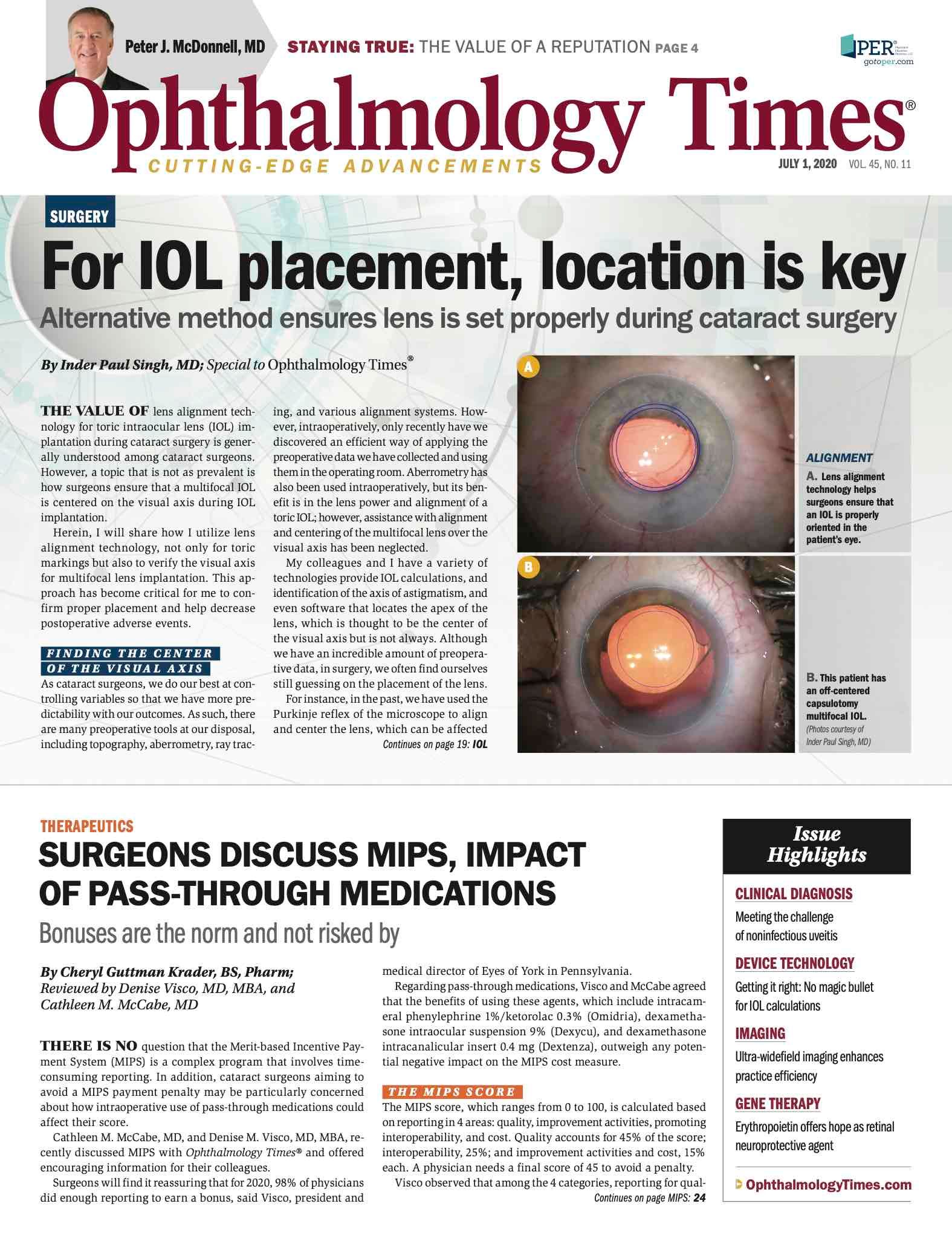Publication
Article
Digital Edition
Getting it right: There is no magic bullet for IOL calculations
Author(s):
Patient expectations continue to push clinicians to look at optimal ways to arrive at the best IOLs.

This article was reviewed by Amandeep Rai MD, FRCSC
No one formula should be exclusively used for IOL calculations to ensure accuracy, according to Amandeep Rai MD, FRCSC, speaking at the Toronto Cataract Course 2020.
“There has been a huge explosion in new formulas and new technologies to make our lives easier and more complex at the same time,” said Rai, a practicing ophthalmologist and former chief resident in the University of Toronto’s ophthalmology residency program. “We have to keep on top of this because it is a rapidly expanding area.”
Rai has observed that when ophthalmology residents are currently asked the question about which IOL calculator to use, the default answer is the Barrett IOL calculator.
“When I started residency, IOL selection depended upon conventional wisdom,” he said.
Related: Haigis-TK power calculation formula provides best error prediction after LASIK
Room for improvement
Although the Barrett IOL calculator is accurate, there is still room for improvement, according to Rai.
“Have we nailed it?” he asked. “No, we have not. Even in that study (with the Barrett IOL calculator), the Barrett (IOL calculator) while being the best- performing formula, was within .05 D of the intended target, 80% of the time.”
Rai noted that even with the Barrett, 20% of eyes are still falling .05 D outside of the intended target.
“That is significant for many of our patients, especially if we are trying to avoid refractive errors,” he said.
Related: Accurate data key for planning toric IOL surgery
The same investigators looked at the updated Olsen formula, which uses anterior chamber depth, keratometry, lens thickness, and axial length to predict effective lens position.
“It was more accurate than Barrett in terms of being within .05 D of the intended target,” Rai explained.
One of the new IOL power formulas is the Kane formula, which a group of investigators measured against 3 new or updated IOL power formulas including the Hill-RBF (radial basis function calculator) Version 2.0 and the Holladay 2 with axial length adjustment compared with existing formulas such as Olsen, Barrett Universal 2, Haigis, Holladay 1, Hoffer Q, and SRK/T, noted Rai.1
A retrospective investigation was performed where the predicted refractive outcome for each formula was calculated for each patient and compared with the actual refractive outcome to supply the prediction error.
Related: Advanced toric IOL calculator improves refractive outcomes
The investigators grouped eyes according to the axial length or the distance from the anterior corneal surface to the retinal pigment epithelium: short, medium, or long.
The Kane formula produced the lowest absolute error in the medium axial length range, and over the entire axial length range, this formula produced the lowest mean absolute prediction error (P <.001) of all formulas.
It was concluded that using 3 measures including axial length, keratometry readings, and anterior chamber depth, that the Kane formula was the most accurate predictor of actual postoperative refraction than other formulas that were studied.1
“The next time someone asks a resident about biometry, perhaps the answer should be ‘Kane,’” Rai added.
Still another investigation from the United Kingdom that included 10,930 eyes of 10,930 patients from the National Health Service concluded that the Kane formula had the lowest mean and median absolute prediction error for short, medium, and long axial length subgroups and for each IOL.
Researchers also observed that updated versions of the Holladay 2 and Hill 2.0 formulas have led to enhanced accuracy.2
“The Kane (formula) was the best-performing formula for short eyes, average eyes, and long eyes,” Rai pointed out. “It was the best of the bunch (of formulas).”
Related: Avoiding IOL refinements after presbyopia-correction surgery
Study other formulas
Although these 2 investigations supported the use of the Kane formula, still other formulas should be studied for their ability to offer extremely accurate IOL calculations, according to Rai.
“We need to look at what is on the horizon,” Rai said. “We need to keep pushing and looking at other things (formulas). It is not as simple as using Kane for all or Barrett for all.”
Rai and colleagues have conducted their own retrospective research and have found intraoperative aberrometry had the highest percentage of eyes within .05 D of the intended target.
“A limitation of the research is that we did not include the Kane (formula),” he said.
One of the newer IOL calculators is the Hill-RBF calculator, developed by ophthalmologist and cataract surgeon, Warren Hill, MD. That calculator, a type of artificial neural network, can be accessed through the American Society of Cataract and Refractive Surgery website.
“This (calculator) has a boundary feature, and it tells you when the eye you are inputting data from is outside of the data set that this formula uses,” Rai noted. “I do not think this is a drawback of the Hill-RBF calculator. I think this is a feature because it helps me to understand if this patient will be in the 20% of patients who are falling .05 D outside of the intended target.”
Related: Trifocal IOL a key for premium cataract surgery practice
Planning surgeries
Rai explained that surgeons can plan their surgeries appropriately.
“You may want to counsel these patients about specialty IOLs,” he said. “You can show the patient preoperatively that the biometry is not normal and that we may have to do more interventions to achieve the patient’s intended target.”
Patient expectations are also pushing clinicians to look at optimal ways to arrive at the best IOLs, noted Rai. “It is nice to be able to compare across new-generation formulas,” he said.
Read more by Louise Gagnon
Amandeep Rai, MD, FRCSC
p: 905-456-3937
Dr Rai has no financial disclosures related to this material.
-----
REFERENCES
1. Connell BJ, Kane JX. Comparison of the Kane formula with existing formulas for intraocular lens power selection. BMJ Open Ophthalmol. 2019;4(1):e000251. doi: 10.1136/bmjophth-2018-000251
2. Darcy K, Gunn D, Tavassoli S, Sparrow J, Kane JX.Assessment of the accuracy of new and updated intraocular lens power calculation formulas in 10 930 eyes from the UK National Health Service. J Cataract Refract Surg. 2020;46(1):2-7. doi: 10.1016/j.jcrs.2019.08.014

Newsletter
Don’t miss out—get Ophthalmology Times updates on the latest clinical advancements and expert interviews, straight to your inbox.




